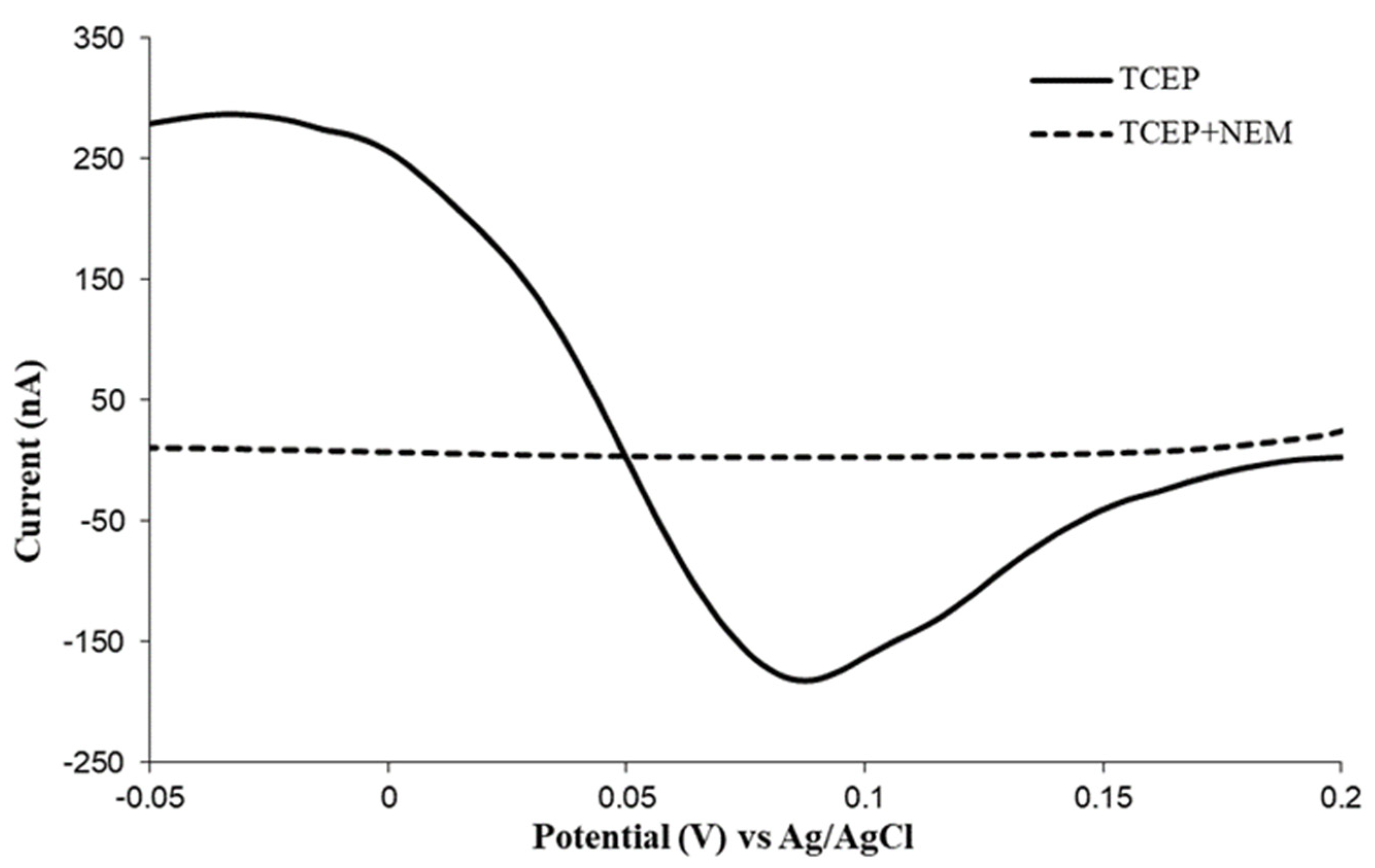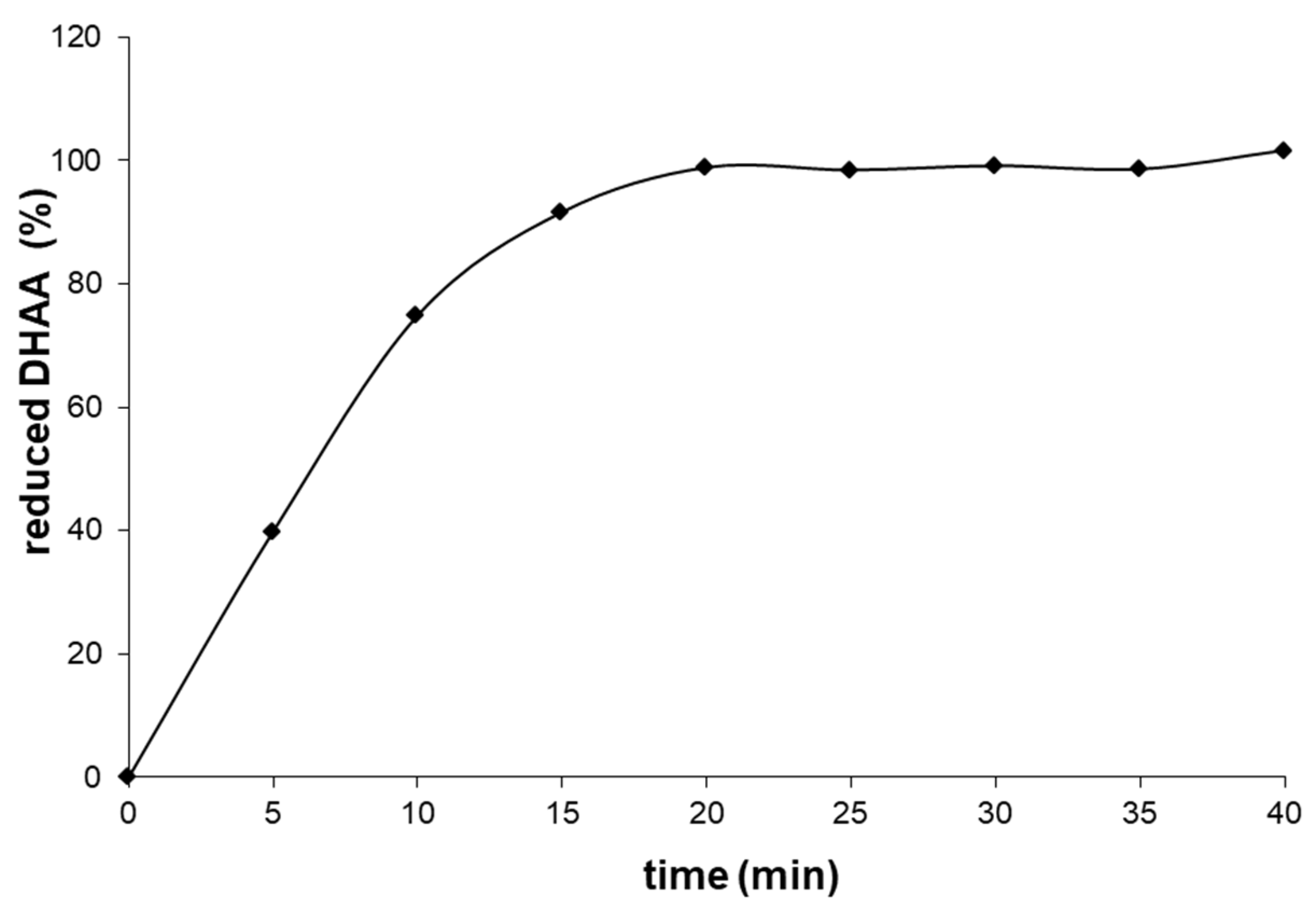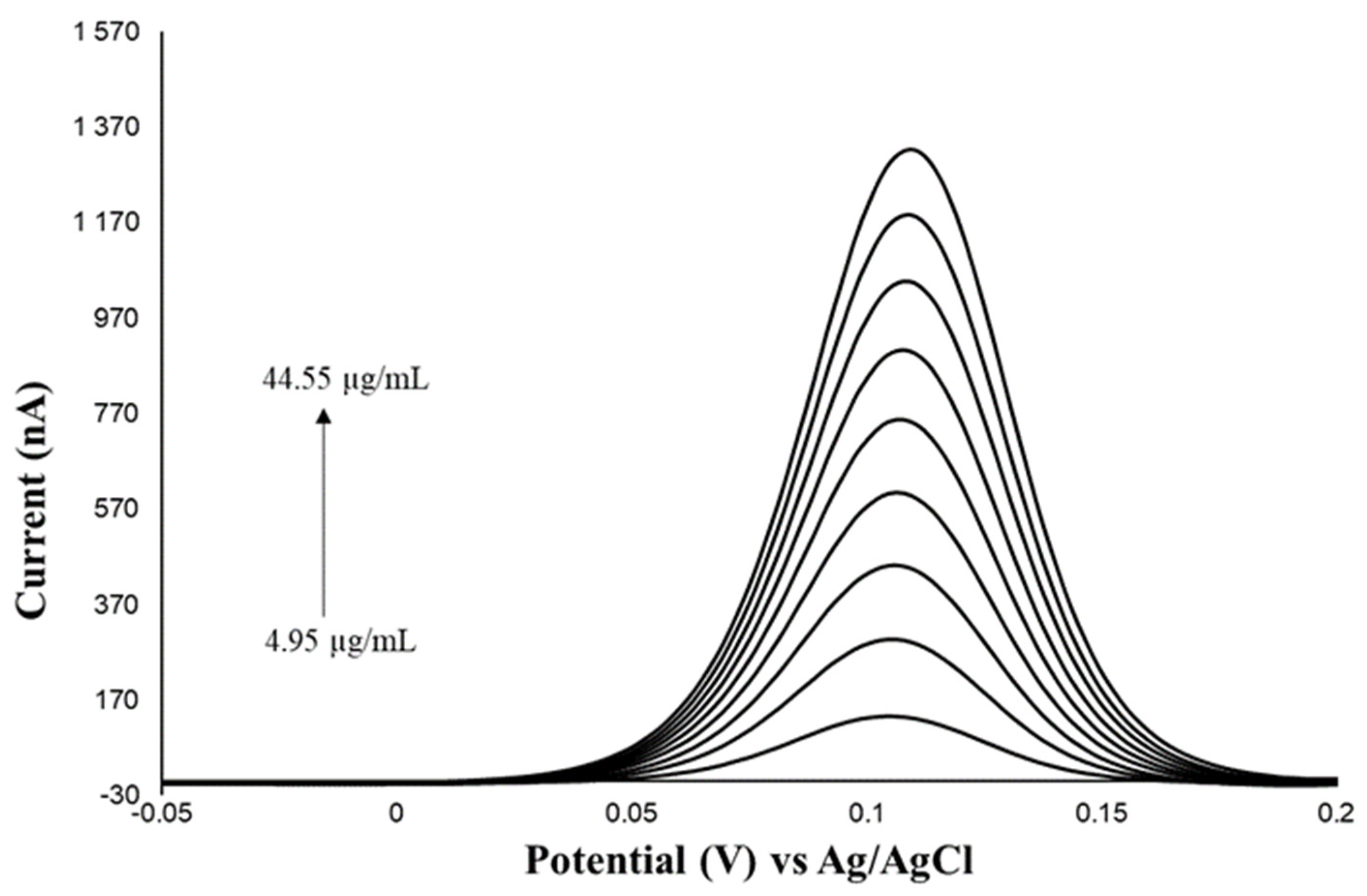A New Method for the Determination of Total Content of Vitamin C, Ascorbic and Dehydroascorbic Acid, in Food Products with the Voltammetric Technique with the Use of Tris(2-carboxyethyl)phosphine as a Reducing Reagent
Abstract
:1. Introduction
2. Results and Discussion
2.1. Method Development
2.2. Method Validation
2.2.1. Linearity
2.2.2. Limits of Detection and Quantification
2.2.3. Precision
2.2.4. Correctness
2.2.5. Recovery
3. Materials and Methods
3.1. Materials
3.2. Chemicals
3.3. Sample Preparation for Analysis
3.4. Procedure of Dehydroascorbic Acid Reduction with the Use of Tris(2-carboxyethyl)phosphine
3.5. HPLC Analysis
3.6. Voltammetric Analysis
3.7. Validation
4. Conclusions
Author Contributions
Funding
Institutional Review Board Statement
Informed Consent Statement
Data Availability Statement
Conflicts of Interest
References
- Johnston, C.; Steinberg, F.; Rucker, R. Ascorbic Acid. In Handbook of Vitamins; CRC Press: Boca Raton, FL, USA, 2007; pp. 489–520. ISBN 978-1-4200-0580-6. [Google Scholar]
- Catani, M.V.; Savini, I.; Rossi, A.; Melino, G.; Avigliano, L. Biological Role of Vitamin C in Keratinocytes. Nutr. Rev. 2005, 63, 81–90. [Google Scholar] [CrossRef] [PubMed]
- Drouin, G.; Godin, J.-R.; Page, B. The Genetics of Vitamin C Loss in Vertebrates. Curr. Genom. 2011, 12, 371–378. [Google Scholar] [CrossRef]
- Tomás-Barberán, F.A.; Gil, M.I. (Eds.) Improving the Health-Promoting Properties of Fruit and Vegetable Products; Woodhead Publishing: Sawston, UK, 2008; ISBN 9781845694289. [Google Scholar]
- Breene, W.M. Healthfulness and Nutritional Quality of Fresh versus Processed Fruits and Vegetables: A Review. Foodserv. Res. Int. 1994, 8, 1–45. [Google Scholar] [CrossRef]
- Mazurek, A.; Pankiewicz, U. Changes of Dehydroascorbic Acid Content in Relation to Total Content of Vitamin C in Selected Fruits and Vegetables. Acta Sci. Pol. Cultus 2012, 11, 169–177. [Google Scholar]
- Wills, R.B.H.; Wimalasiri, P.; Greenfield, H. Dehydroascorbic Acid Levels in Fresh Fruit and Vegetables in Relation to Total Vitamin C Activity. J. Agric. Food Chem. 1984, 32, 836–838. [Google Scholar] [CrossRef]
- Arya, S.; Mahajan, M.; Jain, P. Non-Spectrophotometric Methods for the Determination of Vitamin C. Anal. Chim. Acta 2000, 417, 1–14. [Google Scholar] [CrossRef]
- Novakova, L.; Solich, P.; Solichova, D. HPLC Methods for Simultaneous Determination of Ascorbic and Dehydroascorbic Acids. TrAC Trends Anal. Chem. 2008, 27, 942–958. [Google Scholar] [CrossRef]
- Spínola, V.; Llorent-Martínez, E.J.; Castilho, P.C. Determination of Vitamin C in Foods: Current State of Method Validation. J. Chromatogr. A 2014, 1369, 2–17. [Google Scholar] [CrossRef]
- Lykkesfeldt, J. Determination of Ascorbic Acid and Dehydroascorbic Acid in Biological Samples by High-Performance Liquid Chromatography Using Subtraction Methods: Reliable Reduction with Tris[2-Carboxyethyl]Phosphine Hydrochloride. Anal. Biochem. 2000, 282, 89–93. [Google Scholar] [CrossRef]
- Pisoschi, A.M.; Pop, A.; Serban, A.I.; Fafaneata, C. Electrochemical Methods for Ascorbic Acid Determination. Electrochim. Acta 2014, 121, 443–460. [Google Scholar] [CrossRef]
- Brunetti, B. Recent Advances in Electroanalysis of Vitamins. Electroanalysis 2016, 28, 1930–1942. [Google Scholar] [CrossRef]
- Li, G.; Qi, X.; Zhang, G.; Wang, S.; Li, K.; Wu, J.; Wan, X.; Liu, Y.; Li, Q. Low-Cost Voltammetric Sensors for Robust Determination of Toxic Cd(II) and Pb(II) in Environment and Food Based on Shuttle-like α-Fe2O3 Nanoparticles Decorated β-Bi2O3 Microspheres. Microchem. J. 2022, 179, 107515. [Google Scholar] [CrossRef]
- Demir, E.; İnam, O.; İnam, R. Determination of Ophthalmic Drug Proparacaine Using Multi-Walled Carbon Nanotube Paste Electrode by Square Wave Stripping Voltammetry. Anal. Sci. 2018, 34, 771–776. [Google Scholar] [CrossRef] [PubMed] [Green Version]
- Li, G.; Wu, J.; Qi, X.; Wan, X.; Liu, Y.; Chen, Y.; Xu, L. Molecularly Imprinted Polypyrrole Film-Coated Poly(3,4-Ethylenedioxythiophene):Polystyrene Sulfonate-Functionalized Black Phosphorene for the Selective and Robust Detection of Norfloxacin. Mater. Today Chem. 2022, 26, 101043. [Google Scholar] [CrossRef]
- Pecková, K.; Musilová, J.; Barek, J. Boron-Doped Diamond Film Electrodes—New Tool for Voltammetric Determination of Organic Substances. Crit. Rev. Anal. Chem. 2009, 39, 148–172. [Google Scholar] [CrossRef]
- Sadok, I.; Tyszczuk-Rotko, K.; Szwagierek, A. New Applications of Boron-Doped Diamond Electrode for Voltammetric Determination of Ascorbic Acid. Ann. UMCS Chem. 2016, 70, 13. [Google Scholar] [CrossRef]
- Radovan, C.; Cofan, C.; Cinghita, D. Simultaneous Determination of Acetaminophen and Ascorbic Acid at an Unmodified Boron-Doped Diamond Electrode by Differential Pulse Voltammetry in Buffered Media. Electroanalysis 2008, 20, 1346–1353. [Google Scholar] [CrossRef]
- Sálusová, I.; Cinková, K.; Brtková, B.; Vojs, M.; Marton, M.; Švorc, Ľ. Electrochemical and Analytical Performance of Boron-Doped Diamond Electrode for Determination of Ascorbic Acid. Acta Chim. Slovaca 2017, 10, 21–28. [Google Scholar] [CrossRef] [Green Version]
- Tyszczuk-Rotko, K.; Bęczkowska, I.; Wójciak-Kosior, M.; Sowa, I. Simultaneous Voltammetric Determination of Paracetamol and Ascorbic Acid Using a Boron-Doped Diamond Electrode Modified with Nafion and Lead Films. Talanta 2014, 129, 384–391. [Google Scholar] [CrossRef]
- Lento, H.G.; Daugherty, C.E.; Denton, A.E. Polarographic Determination of Total Acorbic Acid in Foods. J. Agric. Food Chem. 1963, 11, 22–26. [Google Scholar] [CrossRef]
- Mazurek, A.; Włodarczyk-Stasiak, M.; Pankiewicz, U.; Kowalski, R.; Jamroz, J. Development and Validation of a Differential Pulse Polarography Method for Determination of Total Vitamin C and Dehydroascorbic Acid Contents in Foods. LWT 2020, 118, 108828. [Google Scholar] [CrossRef]
- Hansen, R.E.; Winther, J.R. An Introduction to Methods for Analyzing Thiols and Disulfides: Reactions, Reagents, and Practical Considerations. Anal. Biochem. 2009, 394, 147–158. [Google Scholar] [CrossRef]
- Mazurek, A.; Włodarczyk-Stasiak, M.; Jamroz, J. Validation of Differential Pulse Polarographic Method of Ascorbic Acid Assay in Food—Comparison with the Chromatographic Reference Method. Acta Aliment. 2018, 47, 504–512. [Google Scholar] [CrossRef]
- Ono, S.; Takagi, M.; Wasa, T. Polarographic Investigations of Vitamin C. I. On the Oxidation Waves of L-Ascorbic Acid and the Reduction Wave of Dehydro-L-Ascorbic Acid. Bull. Chem. Soc. Jpn. 1958, 31, 356–364. [Google Scholar] [CrossRef]
- Ruiz, J.J.; Aldaz, A.; Dominguez, M. Mechanism of L-Ascorbic Acid Oxidation and Dehydro-L-Ascorbic Acid Reduction on a Mercury Electrode. I. Acid Medium. Can. J. Chem. 1977, 55, 2799–2806. [Google Scholar] [CrossRef]
- Wechtersbach, L.; Cigić, B. Reduction of Dehydroascorbic Acid at Low PH. J. Biochem. Biophys. Methods 2007, 70, 767–772. [Google Scholar] [CrossRef]
- Mazurek, A.; Jamroz, J. Precision of Dehydroascorbic Acid Quantitation with the Use of the Subtraction Method—Validation of HPLC–DAD Method for Determination of Total Vitamin C in Food. Food Chem. 2015, 173, 543–550. [Google Scholar] [CrossRef]
- AOAC. Appendix F: Guidelines for Standard Method Performance Requirements. In AOAC Official Methods of Analysis; AOAC International: Rockville, MD, USA, 2012. [Google Scholar]





| Calibration Curve | y = 29.8957x + 2.5185 |
|---|---|
| Regression coefficient r | 0.9996 |
| tcr | 2.0595 |
| tb * | 175.264 |
| ta * | 0.5300 |
| Sample | Analyte | Mean (mg/100 g) | S * (mg/100 g) | CV * (%) | Horrat * | F * | Recovery ± s (%) | t * |
|---|---|---|---|---|---|---|---|---|
| Parsley leaves | AAs | 204.66 | 8.01 | 3.91 | 0.77 | 4.04 | 106.5 ± 15.2 | 0.73 |
| TC | 226.63 | 4.91 | 2.17 | 0.43 | 2.74 | |||
| DHAAs | 21.97 | 12.43 | 56.57 | 7.96 | 3.32 | |||
| Tomato | AAs | 16.87 | 0.45 | 2.70 | 0.36 | 3.71 | 98.8 ± 3.8 | 0.55 |
| TC | 17.88 | 0.55 | 3.07 | 0.42 | 1.06 | |||
| DHAAs | 1.01 | 0.11 | 11.15 | 0.99 | 15.74 | |||
| Broccoli | AAs | 76.55 | 3.62 | 4.72 | 0.80 | 8.80 | 98.1 ± 8.4 | 0.38 |
| TC | 100.65 | 4.09 | 4.07 | 0.72 | 3.37 | |||
| DHAAs | 24.10 | 2.06 | 8.54 | 1.22 | 2.72 | |||
| Cauliflower | AAs | 91.37 | 3.61 | 3.95 | 0.69 | 1.84 | 95.0 ± 12.8 | 0.67 |
| TC | 113.19 | 5.61 | 4.95 | 0.89 | 3.53 | |||
| DHAAs | 21.81 | 2.34 | 10.74 | 1.51 | 3.34 | |||
| Banana | AAs | 11.73 | 0.78 | 6.67 | 0.85 | 1.72 | 104.9 ± 5.4 | 1.56 |
| TC | 21.15 | 0.93 | 4.39 | 0.61 | 1.11 | |||
| DHAAs | 9.41 | 1.51 | 16.09 | 1.99 | 1.04 | |||
| Lemon | AAs | 45.04 | 3.70 | 8.22 | 1.29 | 3.83 | 103.5 ± 8.4 | 0.71 |
| TC | 53.20 | 3.35 | 6.30 | 1.01 | 1.04 | |||
| DHAAs | 7.82 | 5.20 | 66.54 | 8.02 | 11.17 | |||
| Kiwi fruit | AAs | 108.31 | 2.85 | 2.63 | 0.47 | 4.85 | 96.6 ± 10.2 | 0.57 |
| TC | 119.19 | 2.57 | 2.16 | 0.39 | 7.28 | |||
| DHAAs | 10.88 | 1.12 | 10.27 | 1.30 | 2.19 | |||
| Cucumber | AAs | 5.33 | 0.40 | 7.45 | 0.85 | 1.79 | 105.4 ± 5.0 | 1.85 |
| TC | 6.16 | 0.17 | 2.83 | 0.33 | 5.02 | |||
| DHAAs | 0.83 | 0.30 | 36.37 | 3.13 | 10.45 | |||
| Multivegetable juice | AAs | 40.79 | 1.52 | 3.72 | 0.58 | 1.09 | 95.2 ± 10.5 | 0.78 |
| TC | 42.90 | 1.02 | 2.38 | 0.37 | 2.65 | |||
| DHAAs | 2.10 | 0.89 | 42.35 | 4.19 | 1.02 | |||
| Orange juice | AAs | 21.72 | 1.17 | 5.37 | 0.75 | 1.80 | 99.2 ± 9.8 | 0.14 |
| TC | 25.61 | 1.00 | 3.92 | 0.57 | 2.73 | |||
| DHAAs | 3.89 | 0.18 | 4.58 | 0.50 | 11.83 | |||
| Grapefruit juice | AAs | 29.31 | 0.74 | 2.51 | 0.37 | 2.10 | 116.3 ± 11.5 | 2.44 |
| TC | 33.34 | 1.00 | 2.99 | 0.45 | 1.28 | |||
| DHAAs | 4.03 | 0.27 | 6.60 | 0.72 | 4.15 | |||
| Fruit cream in powder | AAs | 12.05 | 0.48 | 3.98 | 0.51 | 1.08 | 94.6 ± 4.8 | 1.92 |
| TC | 12.54 | 0.53 | 4.26 | 0.55 | 1.14 | |||
| DHAAs | 0.49 | 0.06 | 12.28 | 0.98 | 4.87 | |||
| Multivitamin syrup | AAs | 1043.18 | 28.93 | 2.77 | 0.70 | 2.12 | 101.2 ± 8.5 | 0.23 |
| TC | 1132.76 | 48.18 | 4.25 | 1.08 | 1.47 | |||
| DHAAs | 89.59 | 22.44 | 25.05 | 4.36 | 1.41 | |||
| Infant milk powder | AAs | 80.29 | 2.12 | 2.64 | 0.45 | 1.05 | 102.4 ± 10.7 | 0.38 |
| TC | 81.97 | 3.06 | 3.73 | 0.64 | 3.73 | |||
| DHAAs | 1.68 | 0.94 | 56.01 | 5.35 | 3.07 | |||
| BCR431 | AAs | 468.51 | 7.55 | 1.61 | 0.36 | |||
| TC | 516.97 | 14.03 | 2.71 | 0.61 | ||||
| DHAAs | 48.46 | 21.23 | 43.81 | 6.94 |
| BCR 431 | DPV | |||||
|---|---|---|---|---|---|---|
| XCRM * (mg/100 g) | uCRM * (mg/100 g) | Xm * (mg/100 g) | um * (mg/100 g) | Δm * | UΔ * | Accuracy |
| 483 | 9.8 | 517 | 14 | 34 | 34.23 | yes |
| HPLC-DAD | DPV | ||||||||
|---|---|---|---|---|---|---|---|---|---|
| Sample | Analyte | Mean (mg/100 g) | s * (mg/100 g) | Mean (mg/100 g) | s * (mg/100 g) | P * | U * | Accuracy | t |
| Parsley leaves | AAs | 201.25 | 3.98 | 204.66 | 8.01 | 0.983 | 0.088 | yes | 0.661 |
| TC | 221.91 | 2.97 | 226.63 | 4.91 | 0.979 | 0.051 | yes | 1.422 | |
| DHAAs | 20.67 | 6.82 | 21.97 | 12.43 | 0.941 | 1.330 | yes | 0.159 | |
| Tomato | AAs | 15.43 | 0.88 | 16.87 | 0.45 | 0.914 | 0.122 | yes | 2.531 |
| TC | 16.61 | 0.53 | 17.88 | 0.55 | 0.929 | 0.089 | yes | 2.873 | |
| DHAAs | 1.18 | 0.45 | 1.01 | 0.11 | 1.173 | 0.839 | yes | 0.657 | |
| Broccoli | AAs | 75.86 | 1.22 | 76.55 | 3.62 | 0.991 | 0.100 | yes | 0.311 |
| TC | 97.84 | 2.23 | 100.65 | 4.09 | 0.972 | 0.094 | yes | 1.041 | |
| DHAAs | 21.98 | 3.40 | 24.10 | 2.06 | 0.912 | 0.345 | yes | 0.923 | |
| Cauliflower | AAs | 88.31 | 2.66 | 91.37 | 3.61 | 0.966 | 0.100 | yes | 1.185 |
| TC | 104.35 | 2.99 | 113.19 | 5.61 | 0.922 | 0.117 | yes | 2.410 | |
| DHAAs | 16.04 | 1.28 | 21.81 | 2.34 | 0.735 | 0.282 | yes | 3.743 | |
| Banana | AAs | 11.53 | 1.02 | 11.73 | 0.78 | 0.982 | 0.222 | yes | 0.278 |
| TC | 19.18 | 0.88 | 21.15 | 0.93 | 0.907 | 0.127 | yes | 2.664 | |
| DHAAs | 7.65 | 1.49 | 9.41 | 1.51 | 0.813 | 0.498 | yes | 1.435 | |
| Lemon | AAs | 48.71 | 1.89 | 45.04 | 3.70 | 1.081 | 0.177 | yes | 1.526 |
| TC | 54.03 | 3.41 | 53.20 | 3.35 | 1.016 | 0.178 | yes | 0.303 | |
| DHAAs | 5.33 | 1.56 | 7.82 | 5.20 | 0.681 | 1.653 | yes | 0.932 | |
| Kiwi fruit | AAs | 106.35 | 6.27 | 108.31 | 2.85 | 0.982 | 0.128 | yes | 0.492 |
| TC | 115.31 | 6.94 | 119.19 | 2.57 | 0.967 | 0.126 | yes | 0.907 | |
| DHAAs | 8.96 | 1.65 | 10.88 | 1.12 | 0.823 | 0.402 | yes | 1.667 | |
| Cucumber | AAs | 4.89 | 0.30 | 5.33 | 0.40 | 0.916 | 0.194 | yes | 1.566 |
| TC | 5.88 | 0.39 | 6.16 | 0.17 | 0.954 | 0.142 | yes | 1.149 | |
| DHAAs | 0.99 | 0.09 | 0.83 | 0.30 | 1.199 | 0.693 | yes | 0.905 | |
| Multivegetable juice | AAs | 38.52 | 1.46 | 40.79 | 1.52 | 0.944 | 0.106 | yes | 1.873 |
| TC | 41.09 | 1.66 | 42.90 | 1.02 | 0.958 | 0.093 | yes | 1.601 | |
| DHAAs | 2.58 | 0.90 | 2.10 | 0.89 | 1.226 | 1.082 | yes | 0.649 | |
| Orange juice | AAs | 20.08 | 0.87 | 21.72 | 1.17 | 0.925 | 0.139 | yes | 1.947 |
| TC | 24.36 | 0.61 | 25.61 | 1.00 | 0.951 | 0.094 | yes | 1.840 | |
| DHAAs | 4.28 | 0.61 | 3.89 | 0.18 | 1.099 | 0.313 | yes | 1.049 | |
| Grapefruit juice | AAs | 30.44 | 1.07 | 29.31 | 0.74 | 1.039 | 0.087 | yes | 1.511 |
| TC | 35.20 | 0.88 | 33.34 | 1.00 | 1.056 | 0.078 | yes | 2.419 | |
| DHAAs | 4.76 | 0.54 | 4.03 | 0.27 | 1.181 | 0.275 | yes | 2.096 | |
| Fruit cream in powder | AAs | 12.18 | 0.46 | 12.05 | 0.48 | 1.011 | 0.110 | yes | 0.332 |
| TC | 12.53 | 0.50 | 12.54 | 0.53 | 0.999 | 0.117 | yes | 0.028 | |
| DHAAs | 0.35 | 0.13 | 0.49 | 0.06 | 0.717 | 0.693 | yes | 1.646 | |
| Multivitamin syrup | AAs | 1053.30 | 42.09 | 1043.18 | 28.93 | 1.010 | 0.097 | yes | 0.343 |
| TC | 1096.21 | 39.70 | 1132.76 | 48.18 | 0.968 | 0.112 | yes | 1.014 | |
| DHAAs | 42.91 | 18.89 | 89.59 | 22.44 | 0.479 | 0.885 | yes | 2.757 | |
| Infant milk powder | AAs | 81.05 | 2.18 | 80.29 | 2.12 | 1.009 | 0.075 | yes | 0.433 |
| TC | 83.91 | 1.58 | 81.97 | 3.06 | 1.024 | 0.083 | yes | 0.976 | |
| DHAAs | 2.86 | 1.65 | 1.68 | 0.94 | 1.701 | 1.673 | yes | 1.075 | |
Disclaimer/Publisher’s Note: The statements, opinions and data contained in all publications are solely those of the individual author(s) and contributor(s) and not of MDPI and/or the editor(s). MDPI and/or the editor(s) disclaim responsibility for any injury to people or property resulting from any ideas, methods, instructions or products referred to in the content. |
© 2023 by the authors. Licensee MDPI, Basel, Switzerland. This article is an open access article distributed under the terms and conditions of the Creative Commons Attribution (CC BY) license (https://creativecommons.org/licenses/by/4.0/).
Share and Cite
Mazurek, A.; Włodarczyk-Stasiak, M. A New Method for the Determination of Total Content of Vitamin C, Ascorbic and Dehydroascorbic Acid, in Food Products with the Voltammetric Technique with the Use of Tris(2-carboxyethyl)phosphine as a Reducing Reagent. Molecules 2023, 28, 812. https://doi.org/10.3390/molecules28020812
Mazurek A, Włodarczyk-Stasiak M. A New Method for the Determination of Total Content of Vitamin C, Ascorbic and Dehydroascorbic Acid, in Food Products with the Voltammetric Technique with the Use of Tris(2-carboxyethyl)phosphine as a Reducing Reagent. Molecules. 2023; 28(2):812. https://doi.org/10.3390/molecules28020812
Chicago/Turabian StyleMazurek, Artur, and Marzena Włodarczyk-Stasiak. 2023. "A New Method for the Determination of Total Content of Vitamin C, Ascorbic and Dehydroascorbic Acid, in Food Products with the Voltammetric Technique with the Use of Tris(2-carboxyethyl)phosphine as a Reducing Reagent" Molecules 28, no. 2: 812. https://doi.org/10.3390/molecules28020812






